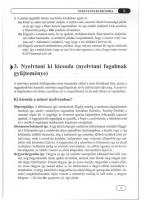Trading the GARTLEY 222
354 51 614KB
English Pages 5 Year 2003
Recommend Papers

File loading please wait...
Citation preview
Trading the GARTLEY 222 Sometimes old trading ideas are the best ideas — if you can quantify them with modern analysis and testing procedures. Here, a "classic" chart pattern is defined mathematically and tested to see if it can produce profits. BY AARON BEHLE AND MARK CONWAY
s an increasingly challenging market has weeded out traders over the past few years, many survivors in search of an edge are revisiting the works of the original technical analysis masters, including Richard Schabacker, J.M. Hurst, W.D. Gann and Harold M. Gartley. Gartley wrote Profits in the Stock Market in 1935, and what makes the book striking is not that it shows how much technical analysis has advanced since then, but rather, how little it has changed. In many cases, "modern" patterns with catchy names are simply rehashes of price behavior observed long ago by people like Gartley. One example is a pattern commonly known as the "butterfly," named for its resemblance to a pair of butterfly wings (see Figure 1, right). However, Gartley described this pattern in Profits in the Stock Market as the "Gartley 222," a reference to the page number on which the discussion occurred. The Gartley 222 can be defined objectively by establishing specific proportions for the four price swings (XA, AB, ВС and CD in Figure 1), or legs, that comprise the pattern, as well as by setting criteria to define the magnitude of the swing ("pivot") highs and lows — points А, В and C.
peak-to-trough or trough-to-peak) as a certain percentage of a preceding price swing. Pesavento required these percentages to be Fibonacci ratios: 0.618, 0.786, 1.00, 1.27 and 1.618. The problem is that if you disregard those patterns whose price swings are not proportional using precise Fibonacci ratios, the Gartley 222 pattern is quite rare. Using a "tolerance percentage" (T%) that expands the range of acceptable priceswing ratios produces more pattern examples and, thus, more trade opportunities. For example, if T% = 10 percent, segment
America Online (AOL), daily
Percentage relationships In his book Profitable Patterns for Stock
Trading, analyst Larry Pesavento used certain ratios to define the butterfly pattern, measuring each price swing (from 38
www.activetradermag.com • August 2003 • ACTIVE TRADER
AB (the second price swing) can be between 51.8 percent and 71.8 percent of segment XA (the first price swing), rather than exactly 61.8 percent. Another criterion that can be applied to the pattern is the "strength" of the pivot points. For example, a pivot high has a strength of 3 when the three bars preceding the high and the three succeeding it are all lower than the high; a pivot high with four preceding and succeeding lower highs would have a strength of 4. Each pivot in the 222 pattern must meet this strength requirement. As the pivot strength increases, so does the length of the pattern and the likely duration of a trade based on it. However, the higher the pivot strength, the fewer patterns that will qualify for trading, and the longer those patterns will be. Pivot strength can also be measured in percentage terms — e.g., a 2-percent swing from peak to trough on a 60minute chart, or a 10 percent swing on a daily chart. These parameters should be appropriate to the time frame; price moves on an intraday chart will be proportionally smaller than those on daily or weekly charts. (With all these criteria, finding the pattern by scanning charts is difficult, at best. Accordingly, code for defining the pattern in both the TradeStation and Wealth-Lab analysis programs can be found at www.activetradermag.com/code.htm.) Using objective criteria for defining price patterns allows you to build a consistent strategy for trading them. We will use specific Gartley 222 pattern parameters to enter both long and short trades on different time frames. Back-testing on the Nasdaq 100 stocks over the past several years will provide an indication of the strategy's potential.
Defining the swing relationships In Figure 1, which shows a bullish 222 pattern, low X to high A defines segment XA; high A to low В defines segment AB, and so on. The first thing to determine is how the size of these price swings should relate to each other. Low В retraces a certain percentage of high A, but is higher than low X. Segment ВС is an even smaller retracement of high A, but segment CD retraces all of segment ВС but is above low X. Point D is the buy point. To measure the retracements, we'll use the proportions defined in Appendix I of Pesavento's book: AB should be 61.8 percent of XA ВС should be 61.8-78.6 percent of AB CD should be 127.0-161.8 percent of ВС AD should be 78.6 percent of XA Figure 2 (above) shows a bearish 222 pattern, which resembles the letter "W." Reversing the logic of the bullish pattern, ACTIVE TRADER • August 2003 • www.activetradermag.com
Morgan Stanley (MWD), daily
peak X to trough A defines the segment XA, trough A to peak В defines the segment AB, etc. High В retraces a percentage of trough A but is lower than high X. Again, segment CD retraces all of segment ВС but does not reach the point X high. Point D is the sell short point. The pattern lines in Figure 2 are based on the following criteria: 1. Pivot strength = 3 2. Maximum number of bars in pattern =100 3. T% = 10 percent
Gartley 222 strategy A Gartley 222 setup should always have a minimum potential reward/risk ratio of 2:1. This system uses a stop-loss at Point X and a profit target equal to 61.8 percent of segment CD ("DT" in the following calculations). The profit target for a bullish butterfly will be equal to Point D + DT, and the short target for a bearish butterfly will be D - DT. The calculations used are: XA = | X - A | AB = | A - В | BC= | B - C | D = A - (0.786 * XA) for bullish butterfly D = A + (0.786 * XA) for bearish butterfly CD=|C-D| AD = | A - D | DT = 0.618 * CD Tolerance = T% continued on p. 40
39
Entry rules Bullish Gartley 222: 1. A > С and С > В and В > D and D > X 2. The pattern must be a trough-peak-trough-peak sequence 3. AB / XA > 0.618 - T% and AB / XA 0.618 - T% and ВС / AB > 0.786 + T% 5. Repeat for CD / ВС and AD / XA. 6. If the conditions above are true, then buy at price D with a limit order. Bearish Gartley 222: 1. A
![The Gartley Trading Method: New Techniques To Profit from the Markets Most Powerful Formation (Wiley Trading) [1 ed.]
0470583541, 9780470583548](https://ebin.pub/img/200x200/the-gartley-trading-method-new-techniques-to-profit-from-the-markets-most-powerful-formation-wiley-trading-1nbsped-0470583541-9780470583548.jpg)








